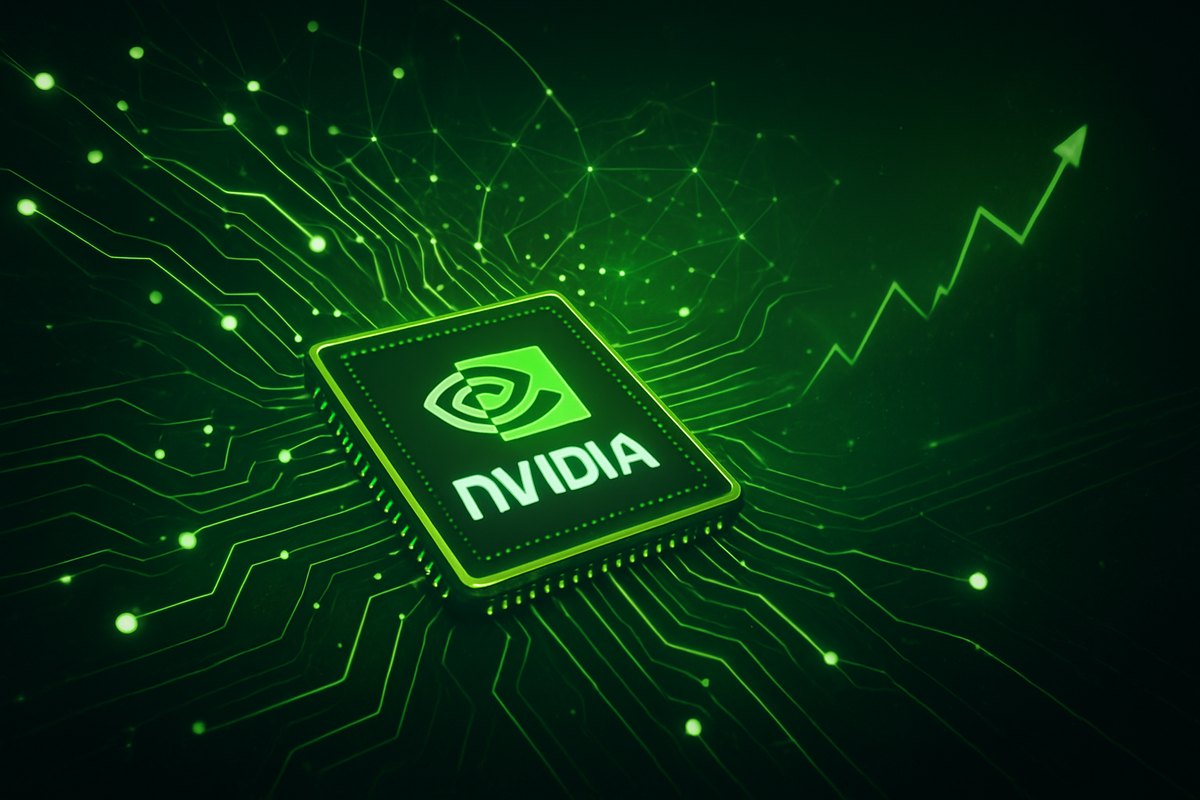
November 6, 2025 – In a market characterized by a broader tech sector pullback and investor anxiety, NVIDIA (NASDAQ: NVDA) stands out today as a beacon of resilience, reinforcing its status as a "Promising Technology Stock Worth Watching." While the broader Nasdaq index has seen declines and profit-taking, NVIDIA's long-term trajectory and fundamental strengths continue to drive significant investor confidence, even amidst short-term fluctuations. The company’s unwavering leadership in artificial intelligence hardware and its strategic positioning at the forefront of the AI revolution are proving to be powerful antidotes to prevailing market headwinds.
Despite recent short-term dips in its stock price earlier this week, reflecting general market unease, NVIDIA's year-to-date performance remains exceptionally robust, significantly outperforming major indices. This sustained upward movement underscores the market's conviction in NVIDIA's indispensable role in powering the global AI infrastructure. As the world races towards an AI-first future, the demand for NVIDIA's cutting-edge GPUs and comprehensive AI ecosystem continues to soar, translating into impressive financial results and an optimistic outlook for the tech giant.
The AI Juggernaut: Unpacking NVIDIA's Market Momentum
NVIDIA's current strong performance, even against a backdrop of a generally down market, is not merely a fleeting moment but the culmination of strategic innovation and market dominance. While the stock experienced minor corrections in the days immediately preceding November 6, shedding a few percentage points amidst broader tech sector profit-taking, its overall trajectory for 2025 has been nothing short of spectacular. As of November 5, 2025, NVIDIA had gained nearly 50% year-to-date, dwarfing the S&P 500's (NYSEARCA: SPY) 18.33% increase over the same 12-month period. This exceptional outperformance signals a deep-seated belief among investors in the company's long-term growth prospects.
The primary catalyst for this sustained momentum is NVIDIA's undisputed leadership in the artificial intelligence sector. Its Graphics Processing Units (GPUs) are the "gold standard" for training and deploying advanced AI models, making the company the de facto "backbone of the AI revolution." The introduction of next-generation architectures, particularly Blackwell in 2025, has been a significant game-changer. Blackwell offers more than twice the speed for AI model training compared to its predecessor, Hopper, and demand has already far outstripped production capacity. NVIDIA has reportedly secured over $500 billion in cumulative revenue orders for its Blackwell and upcoming Rubin products extending into 2026, marking the fastest product ramp-up in the company's history. This overwhelming demand, especially from hyperscalers and major tech giants like Microsoft (NASDAQ: MSFT), Amazon (NASDAQ: AMZN), Google (NASDAQ: GOOGL), and Meta (NASDAQ: META), is fueling explosive growth in NVIDIA's data center segment, which saw a staggering 93% year-over-year increase to $35.6 billion in Q4 Fiscal Year 2025.
Beyond hardware, NVIDIA's proprietary Compute Unified Device Architecture (CUDA) software platform creates a formidable ecosystem that effectively locks in customers and erects a significant barrier to entry for competitors. This "CUDA lock-in" ensures that developers and enterprises heavily invested in NVIDIA's software stack are unlikely to switch to alternative hardware providers, solidifying the company's dominant market position. Strategic partnerships, such as the recent $1.15 billion deal with Deutsche Telekom (XTRA: DTE) to build an AI factory in Europe, further illustrate NVIDIA's expanding global footprint and its critical role in enabling AI infrastructure worldwide. Investors are also keenly anticipating NVIDIA’s Q3 fiscal 2026 earnings report on November 19, 2025, with high expectations for continued significant EPS and revenue growth, which could provide further impetus for the stock.
Winners and Losers in the NVIDIA AI Wave
NVIDIA's (NASDAQ: NVDA) relentless march in the AI sector creates a clear delineation of potential winners and losers across the technology landscape. The most immediate and significant beneficiaries are the hyperscale cloud providers and large enterprises heavily investing in AI infrastructure. Companies like Microsoft (NASDAQ: MSFT) with Azure, Amazon (NASDAQ: AMZN) with AWS, Google (NASDAQ: GOOGL) with Google Cloud Platform, and Oracle (NYSE: ORCL) with Oracle Cloud Infrastructure are all massive purchasers of NVIDIA's GPUs to power their AI services and offerings. As these companies pour billions into AI computing, NVIDIA's revenue streams are directly bolstered. Their ability to offer cutting-edge AI capabilities, powered by NVIDIA's hardware, allows them to attract and retain enterprise clients seeking to leverage advanced AI for their operations.
Furthermore, companies specializing in AI development, machine learning, and data analytics stand to gain immensely. These firms, ranging from startups to established players, rely on NVIDIA's powerful processing capabilities to train complex models, develop new AI applications, and extract insights from vast datasets. The efficiency and speed offered by NVIDIA's Blackwell and Rubin architectures enable these companies to innovate faster and bring more sophisticated AI solutions to market, potentially giving them a competitive edge in their respective industries. Manufacturers of high-bandwidth memory (HBM) and other specialized components used in NVIDIA's advanced GPUs, such as Samsung (KRX: 005930) and SK Hynix (KRX: 000660), also benefit from the surging demand for NVIDIA's products.
Conversely, the intense competition fostered by NVIDIA's dominance poses significant challenges for rival chip manufacturers and those attempting to build alternative AI ecosystems. While companies like Advanced Micro Devices (NASDAQ: AMD) are making strides with their Instinct accelerators, and Intel (NASDAQ: INTC) is pushing its Gaudi processors, overcoming NVIDIA's established market share, performance lead, and the entrenched CUDA ecosystem is an uphill battle. These competitors face immense pressure to innovate rapidly and offer compelling price-to-performance ratios to carve out meaningful market share. Companies that have not adequately invested in AI capabilities or those whose business models are disrupted by the rapid advancements in AI – potentially enabled by NVIDIA's technology – could also face headwinds. This includes some traditional software providers or service companies that may struggle to adapt to an increasingly AI-driven landscape without leveraging the foundational hardware provided by leaders like NVIDIA.
Broader Implications and Industry Transformation
NVIDIA's (NASDAQ: NVDA) sustained surge in the financial markets and its technological breakthroughs are not merely isolated corporate successes; they represent a pivotal force shaping broader industry trends and potentially triggering significant ripple effects across the global economy. The most evident trend is the accelerated adoption of AI across all sectors. NVIDIA's powerful and increasingly accessible hardware is democratizing advanced AI capabilities, allowing industries from healthcare and finance to manufacturing and logistics to implement sophisticated AI solutions that were previously unimaginable or cost-prohibitive. This drives a massive capital expenditure cycle in data centers and cloud infrastructure, fundamentally transforming how businesses operate and innovate.
The ripple effects extend directly to competitors and partners. For rivals like AMD (NASDAQ: AMD) and Intel (NASDAQ: INTC), NVIDIA's lead intensifies the pressure to innovate faster and more effectively in the AI accelerator space. While competition is emerging, NVIDIA's CUDA ecosystem provides a significant "moat," challenging competitors to not only match hardware performance but also build equally robust and developer-friendly software platforms. For partners, particularly cloud service providers, their reliance on NVIDIA's technology deepens, cementing NVIDIA's position as a critical enabler of their AI offerings. This also highlights a growing concentration of power in the hands of a few key technology providers, which could eventually draw increased scrutiny from regulatory bodies. Concerns around market dominance, potential anti-competitive practices, or the concentration of AI development in a few hands could lead to future regulatory or policy implications, though currently, the focus remains largely on fostering AI innovation.
Historically, the current situation echoes past technological paradigm shifts, such as the rise of personal computing with Intel's dominance in CPUs or the internet boom. In each instance, a foundational technology provider emerged to enable widespread adoption and innovation. NVIDIA is playing a similar role for AI. Its current trajectory suggests a potential for it to become one of the most influential companies of this decade, akin to how Microsoft (NASDAQ: MSFT) and Apple (NASDAQ: AAPL) defined previous eras of computing. The sheer scale of the AI infrastructure opportunity, with projections of potentially $4 trillion more in spending throughout the decade, underscores the long-term significance of NVIDIA's pioneering efforts. This event signals a deepening commitment from global industries to integrate AI at every level, with NVIDIA serving as the primary architect of this new technological era.
The Road Ahead: Navigating AI's Frontier
Looking ahead, NVIDIA's (NASDAQ: NVDA) trajectory suggests a future defined by both immense opportunities and evolving challenges. In the short-term, the market will be closely watching the company's Q3 fiscal 2026 earnings report on November 19, 2025. Strong results and optimistic guidance, particularly concerning demand for Blackwell and Rubin architectures and data center growth, could provide another significant boost to the stock. The continued rollout and adoption of Blackwell, alongside further details on Rubin, will be critical milestones. NVIDIA's ability to ramp up production to meet the insatiable demand for its chips will also be a key factor in maintaining its growth momentum.
In the long-term, NVIDIA is poised to expand its influence beyond core AI accelerators. Potential strategic pivots include deeper dives into robotics, edge AI, and autonomous systems, leveraging its GPU technology and AI expertise to power a new generation of intelligent machines. The company's ongoing investment in research and development will be crucial to maintaining its technological edge against emerging competitors. Market opportunities will continue to emerge from the ever-broadening application of AI across industries, from scientific research to creative content generation. NVIDIA's comprehensive ecosystem, including software platforms like CUDA and development tools, will be instrumental in fostering these new markets.
However, challenges loom. Geopolitical tensions and potential U.S. export curbs, particularly concerning the Chinese market, could impact revenue streams and force strategic adaptations. The rise of emerging competition from both established players and well-funded startups in the AI chip space will require NVIDIA to continuously innovate and defend its market share. Furthermore, customer concentration, with a significant portion of its revenue coming from a few hyperscale cloud providers, presents a potential vulnerability that NVIDIA will need to manage through diversification and expanded partnerships. Potential scenarios include NVIDIA solidifying its near-monopoly in high-end AI training, or facing increasing pressure from custom AI chips developed by its own customers. The most likely outcome, however, is NVIDIA continuing to lead, driven by its innovation cycle and ecosystem lock-in, adapting to new market demands and maintaining its pivotal role in the AI-driven transformation.
A New Era of Computing: NVIDIA's Lasting Impact
NVIDIA's (NASDAQ: NVDA) strong performance today, amidst a generally down market, serves as a powerful testament to its entrenched position at the epicenter of the artificial intelligence revolution. The key takeaways from this event are clear: NVIDIA's dominance in AI hardware, fueled by its next-generation Blackwell and Rubin architectures, is generating unprecedented demand from data centers and hyperscale cloud providers. Its proprietary CUDA ecosystem creates a formidable competitive moat, ensuring customer loyalty and sustained technological leadership. Despite short-term market corrections, the company's long-term growth trajectory remains robust, significantly outperforming broader market indices and solidifying its status as a "Promising Technology Stock Worth Watching."
Moving forward, the market will continue to assess NVIDIA through the lens of AI adoption and innovation. The company's upcoming Q3 fiscal 2026 earnings report on November 19, 2025, will be a critical indicator of its continued financial health and growth prospects. Investors should also watch for NVIDIA's strategic expansions into new AI frontiers such as robotics and autonomous systems, which represent future avenues for diversification and growth. The ongoing interplay between increasing global demand for AI, the competitive landscape in AI chip development, and potential regulatory scrutiny will also shape NVIDIA's path in the coming months and years.
Ultimately, NVIDIA is not just a chipmaker; it is a foundational architect of the future of computing. Its innovations are enabling breakthroughs across scientific research, industrial automation, and everyday life, positioning it as one of the most influential companies of our time. The lasting impact of NVIDIA's current trajectory will be the acceleration of the AI era, fundamentally reshaping industries and driving unprecedented technological advancements. As the world continues its rapid embrace of AI, NVIDIA's role as an indispensable enabler ensures its significance and influence will only grow, making it a pivotal stock for investors to monitor closely in the evolving financial landscape.
This content is intended for informational purposes only and is not financial advice




